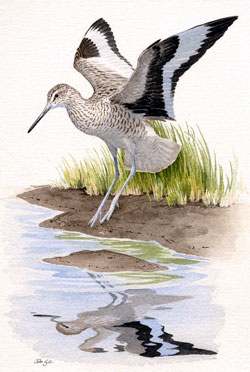Breeding Bird Atlases (BBA)
Find a Bird - BBA1
Breeding Bird Atlas 1 Species Accounts
Willet
Catoptrophorus semipalmatus
Egg Dates
late May to mid-June
Number of Broods
one

Most early accounts of the Willet note its absence as a nesting species in Massachusetts. Once a breeder along the coast from Nova Scotia to Texas, the Willet suffered drastic population declines due to market gunning in the late 1800s and early 1900s. The result was a fragmented breeding range, with the birds largely wiped out north of Virginia. Willets remained rare spring and casual fall migrants in the Commonwealth; however, with full protection, the species has begun to recover. Willets returned to breed in New England in 1971, when nesting was confirmed in southern Maine. The first recent Massachusetts nesting occurred during the Atlas period in 1976.
Migration in the spring may be offshore, with Willets dropping out along the coast at their nesting beaches. The birds begin moving north in March and reach Massachusetts by May 1. They can be seen foraging in and around salt marshes, tidal flats, and sandy beaches for insects, worms, mollusks, fish, seeds, and plant shoots.
Willets are very vocal birds, certainly more so than most other shorebirds. They make intruders aware of their presence with a loud pill-will-willet, a repetitive kip-kip-kip, or a whee-wee-wee while in flight. The vocalizations diminish as the nesting season winds down. Courtship is equally visible and noisy, with the male chasing the female, calling and fluttering his boldly marked wings, and seeming to hang motionless in the air. On the ground, the male holds up his wings in order to highlight the pattern. Males can also be seen doing a very high-stepping strut. After pairing, the female chooses the nest site. Willets can be colonial nesters, but the spacing of nests is often greater than 200 feet. They do not vigorously defend a territory like other shorebirds, but they will attack intruders by swooping and circling while calling.
Willets are among the relatively few shorebirds that do not nest in the Arctic. Their cup-shaped, grass-lined nest is placed either on the ground in a salt marsh or in the open on a sandy beach. Willet eggs are ovate in shape and deep buff to olive in color with dark, bold, irregular splotches and swirls. The usual clutch size is four. Eggs hatch in the order in which they are laid after an incubation period of 22 to 29 days. The young have short beaks, are precocial, and are camouflaged in buff to sepia down. Juvenal plumage is attained when they are half-grown. Both parents incubate and help raise the young. The age of fledging has not been recorded.
During the Atlas period, a territorial pair of Willets was present at Plum Island in 1975, but breeding was not confirmed. In 1976, a pair on North Monomoy positively nested, and a half-grown chick was observed on July 7. Since then, the species has continued to breed in the state in increasing numbers.
In the late summer, large numbers of Willets stage on the tidal flats prior to their southward migration. Willets winter on coastal beaches from the southern United States to Brazil.
Map Legend and Data Summary
Atlas 1 data collected from 1975-1979


Note: uncommon and local in extensive coastal marshes; increasing dramatically
Robert Prescott



